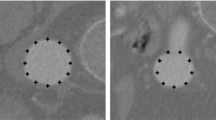Abstract
Object This article describes a method for automated extraction of branching structures in three dimensional (3D) medical images.
Materials and methods The algorithm recursively tracks branches and detects bifurcations by analyzing the binary connected components on the surface of a sphere that moves along the vessels. Local segmentation within the sphere is performed using a clustering algorithm based on both geometric and intensity information. It minimizes a combination of the intra-class intensity variances and of the inertia moment of the “vessel” class, which emphasizes the cylindrical structures. The algorithm was applied to 16 MRA and 12 CTA 3D images of different anatomic regions. Its capability of extracting all the branches and avoiding spurious detections was evaluated by comparing the number of extracted branches with the number of branches found by visual inspection of the datasets. Its reproducibility and sensitivity to parameter variation were also assessed.
Results With a fixed parameter setting, 68 out of 286 perceptible branches were missed or partly extracted and 11 spurious branches were obtained. Increasing the weight of the geometric criterion helped in tracking the principal branches in noisy data but increased the number of missed branches. Processing time was within 5 min per dataset.
Conclusion From one initial point, the algorithm extracts a vascular tree where the differences of size and of intensity between the branches are not large. Missed sub-trees can be recovered using additional starting points.
Similar content being viewed by others
References
Suri JS, Liu K, Reden L, Laxminarayan S (2002). A review on MR vascular image processing: skeleton versus nonskeleton approaches: part II. IEEE Trans Inf Technol Biomed 6:338–350
Tizon X (2004) Algorithms for the analysis of 3D magnetic resonance angiography images (Acta Universitatis Agriculturæ Sueciæ, Uppsala, ISBN 91-576-670-4
Wink O (2004) Vessel axis determination (Print Partner Ipskamp, Amsterdam, ISBN 90-393-3698-9
Kirbas C, Quek FKH (2004). A review of vessel extraction techniques and algorithms. ACM Comput Surv 36:81–121
Hernández Hoyos M, Orkisz M, Douek PC, Magnin IE (2005). Assessment of carotid artery stenoses in 3D contrast-enhanced magnetic resonance angiography, based on improved generation of the centerline. Mach Graph Vis 22:349–378
Bullitt E, Aylward S, Smith K, Mukherji S, Jiroutek M, Muller K (2001). Symbolic description of intracerebral vessels segmented from magnetic resonance angiograms and evaluation by comparison with X-ray angiograms. Med Image Anal 5:157–169
Aylward S, Bullitt E (2002). Initialization, noise, singularities and scale in height ridge traversal for tubular object centerline extraction. IEEE Trans Med Imaging 21(2):61–75
Toumoulin C, Boldak C, Dillenseger JL, Coatrieux JL, Rolland Y (2001). Fast detection and characterization of vessels in very large data sets using geometrical moments. IEEE Trans Biomed Eng 48:604–606
Shim H, Yun ID, Lee KM, Lee SU (2005) Partition-based extraction of cerebral arteries from CT angiography with emphasis on adaptive tracking. In: Information processing med imaging, Glenwood Springs. LNCS, vol 3565. Springer, Heidelberg, pp 357–368
Yim PJ, Choyke PL, Summers RM (2000). Gray-scale skeletonization of small vessels in magnetic resonance angiography. IEEE Trans Med Imaging 19:568–576
Descoteaux M, Collins L, Siddiqi K (2004) Geometric flows for segmenting vasculature in MRI: theory and validation. In: MICCAI—med image computing and computer-assisted intervention, Saint-Malo, France, Springer Verlag LNCS 3216:500–507
Manniesing R, Niessen W (2004) Local speed functions in level set based vessel segmentation. In: MICCAI—med image computing and computer-assisted intervention, Saint-Malo. LNCS, vol 3216. Springer, Heidelberg, pp 475–482
Lorenz C, Renisch S, Schlathölter T, Bülow T (2003). Simultaneous segmentation and tree reconstruction of the coronary arteries in MSCT images. In: Med imaging, San Diego. Proc SPIE 5031:167–177
Shikata H, Hoffman EA, Sonka M (2004) Automated segmentation of pulmonary vascular tree from 3D CT images. In: med imaging, San Diego. Proc SPIE 5369:107–116, doi: 10.1117/12.537032
Agam G, Armato SG, Wu C (2005). Vessel tree reconstruction in thoracic CT scans with application to nodule detection. IEEE Trans Med Imaging 24:486–499
Flasque N, Desvignes M, Constans JM, Revenu M (2001). Acquisition, segmentation and tracking of the cerebral vascular tree on 3D magnetic resonance angiography images. Med Image Anal 5:173–183
Antiga L, Ene-Iordache B, Remuzzi G, Remuzzi A (2001). Automatic generation of glomerular capillary topological organization. Microvascular Research 62:346–354
Carrillo JF, Orkisz M, Hernández Hoyos M (2005) Extraction of 3D vascular tree skeletons based on the analysis of connected components evolution. In: CAIP’2005—11th Int IAPR Conference computer analysis of images and patterns, Versailles. LNCS, vol 3691. Springer, Heidelberg, pp 604–611
MacQueen J (1967) Some methods for classification and analysis of multivariate observations. In: 5th Berkeley Symposium Math Stat and Prob, Berkeley, University of California Press 1:281–297
Otsu N (1979). A threshold selection method from gray-level histograms. IEEE Trans Syst Man Cyber. (SMC) 9(1):63–66
Mukundan R, Ramakrishnan KR (1998). Moment functions in image analysis, theory and applications. World Scientific Publishing Co. Pte. Ltd., Singapore, 150 p
Saito T and Toriwaki JI (1994). New algorithms for Euclidean distance transformations of an n-dimensional digitised picture with applications. Pattern Recogn 27:1551–1565
Wink O, Niessen WJ, Frangi AF, Verdonck B, Viergever MA (2002). 3D MRA coronary axis determination using a minimum cost path approach. Magn Res Med 47:1169–1175
Author information
Authors and Affiliations
Corresponding author
Rights and permissions
About this article
Cite this article
Carrillo, J.F., Hoyos, M.H., Dávila, E.E. et al. Recursive tracking of vascular tree axes in 3D medical images. Int J CARS 1, 331–339 (2007). https://doi.org/10.1007/s11548-007-0068-6
Received:
Accepted:
Published:
Issue Date:
DOI: https://doi.org/10.1007/s11548-007-0068-6




